The Sevilla-Villa medal
by David Hughes
The (1915) Sevilla-Villa medal is a high-relief crown-sized silver piece depicting General Francisco Villa, commander of the largest army of the Revolution at the time, the Army of the North (Ejército del Norte). Manuel Sevilla, an engraver from Mexico City, was rather heavily- handed “encouraged” to stick around, work for the revolutionists, engrave, and make dies for the Chihuahua Revolutionary coinage: - the 1914-15 5¢, 1915 10¢, the 1915 V¢ pattern, and the 1915 Army of the North peso (Flores, 2005).
(As an aside, the so-called “Sevilla-Sevilla Chihuahua 1915 peso pattern”, with Sevilla’s name on both sides, is a modern die-struck fantasy, first appearing in the late 1960s/early 1970s, often initially in sets of four flavors (silver, copper, brass and lead). It is a very attractive high quality and high-relief piece, but is a modern strike, and certainly not a Sevilla pattern of the times, as often described).
Sevilla apparently used a photograph taken of Villa in a military uniform as a model for the die. The tunic is dark in the photo, and appears, on my cursory internet search, in photos when Villa entered Mexico City with General Emiliano Zapata on 6 December 1914.
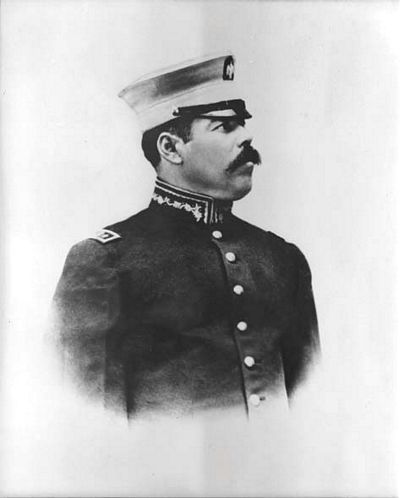
Apparent studio photograph of General Francisco Villa, probably Mexico City late 1914-early 1915. Photograph provided by University of North Texas Libraries, The Portal to Texas History (https://texashistory. unt.edu/ark:/67531/metapth63662); crediting El Paso Public Library.
There are two varieties of the Sevilla-Villa medal. The first is a possibly unique plain edge die trial struck before final die polishing. Die marks incurred during engraving are present, as well as die layout lines.
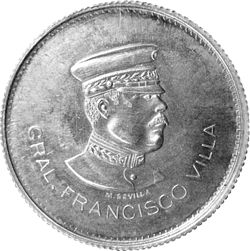
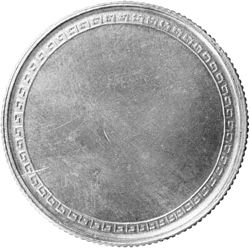
Sevilla-Villa medal struck on polished 1915 Army of the North peso planchets, using polished dies. The heavy strike necessary to bring up the relief has cracked the dies, at 12:00 on the obverse and 8:30 on the reverse.
The second variety is the piece usually seen, with polished dies struck on selected and polished heavy-weight reeded edge Army of the North peso planchets).
The dies were apparently polished on a lathe, and circular polish marks, hard to see on the plate, are present. Die markings are reduced compared to the earlier striking, but the die layout line between cap and tunic is still present. These pieces were struck hard to bring up the high relief bust, and a radial die crack is noted developing at 12:00 on the obverse, as well as another crack developing on the blank reverse. Two or so reeded edge copper strikes are also known.
It has been suggested these were patterns for a peso coin, but most agree it is a medal. The blank reverse was probably intended for engraving. In the sale of the Bothamley specimenBothamley sale, June 1976, Superior Stamp & Coin Co., Beverly Hills, CA it was noted several attempts to add a name on the reverse had been made.
Richard LongRichard Long. Auction #79 Karam sale, October 1995, Langlois, OR. has reported 25 or so struck, per an old letter from the 1920s. The rapid appearance of die cracks suggests a short die life, brought on by the heavy strike needed to bring up the high relief. It appears they were struck in 1915 at the Chihuahua Revolutionary mint, based on the probable timing of engraving, the use of the mint machinery, the 1915 peso planchet, and the fact that the engraver Sevilla subsequently escaped to the US with his son in 1915Joe Flores, “Manuel Sevilla (Engraver-Artist)” in USMexNA journal, June 2005. (available on the USMexNA online library).
After defeat in the 1915 Sonora campaign, Villa’s army dispersed and Villa returned to his local roots. His 1916 shoot-up-and-burn of Columbus, New Mexico provoked a US Army incursion into Mexico that could not catch him. In 1920, he retired from fighting to a hacienda with his soldiers (Los Dorados, The Golden Ones) at Canutillo, Durango, and in 1923 he was assassinated during a visit to Parral, Chihuahua. Rifle cartridges found at the scene were of the Federal army type, possibly signifying nothing.
The Sevilla-Villa medal fits right into a Revolutionary collection, from the subject (Villa), the engraver (Sevilla), the planchets (Chihuahua 1915 pesos), the strike (Chihuahua Revolutionary mint) and the times (1915). They are a proof strike from the middle of a war, among usually crudely engraved and struck coins, and are a nice crown-sized piece in a field lacking in the same (beyond the five main crown-sized pieces of the Revolution, you collect varieties and ultra- rarities, and Federal pesos).
A counterfeit medal
>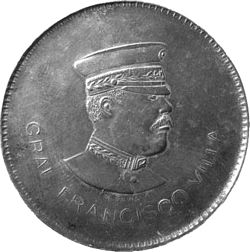
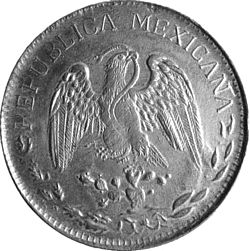
The eBay offering was the Sevilla-Villa obverse paired with the Chihuahua 1915 peso eagle die, both engraved by Sevilla. This, I thought, was the origin of the peso pattern story, a coin not previously reported and not totally unlikely, and I took it with my bid. On arrival, though it was a modern cast counterfeit, fairly nicely done.
The eBay cast counterfeit. Note the casting pinholes in the cheek and jaw of Villa, the casting “crud” (lighter color) in the protected edges and around the letters, and the overall weakness in design and lettering. The Eagle pattern coin was a softer-strike later die state peso (missing crossbars on As in MEXICANA). This piece has been polished, and hairlines are present.
Counterfeit indications (and these are not limited to this particular coin, and serve as warning signs) include:
This piece is cast, whereas the genuine pieces are struck. Casting pinholes are present, especially on the cheek of Villa and under the tail of the eagle.
Fields are uneven instead of flat, and the distinctive die markings and die polish, the “fingerprints” of the die, are absent. This piece is polished, with hairlines in multiple directions.
Loss of detail in the lettering. Rough (instead of sharp) margins between the edges of the bust and eagle, and the fields. Casting “crud” or polish in the protected areas (e.g. under the bust of Villa).
Highly unlikely relief on the piece. The Sevilla-Villa obverse is a high-relief engraving of Villa: on the opposite side of the counterfeit piece is the Chihuahua peso eagle. A struck coin would either have both the Villa bust and the eagle struck up, or weakness in each. This piece has a strong Villa bust, as typical for the hard-struck medals, and a weak eagle breast, as typical for softer-strike 1915 Chihuahua pesos
Mass is excessively light at 21.6 grams. Mass of the Chihuahua peso in Plate 4 is 29.27 grams; the mass of the reeded edge Sevilla-Villa medal in Plate 2 is 29.78 grams.
The reeding, although nicely done, does not match the reeding on the Sevilla-Villa medal or the 1915 Chihuahua peso (on a side-by-side comparison of the medal and the peso, the reeding is the same).
The diameter, also nicely done, is wrong. The genuine medal and peso, are 38.53 mm, the cast counterfeit is 38.50 mm, noticeably smaller when compared side-by-side.
Ring is wrong, compared to the 1915 Chihuahua peso.
A serious collector needs to study the standard counterfeits in the field, as the bogus pieces are as distinctive as the genuine coins (observed by Richard Long and seconded by author).
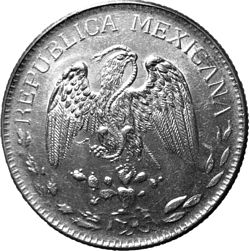 The eagle of the 1915 Army of the North peso. This eagle die is in approximately the same die state as the counterfeit eagle pattern coin. The opposite side of this well-struck example has a full LIBERTAD in the Liberty Cap.
The eagle of the 1915 Army of the North peso. This eagle die is in approximately the same die state as the counterfeit eagle pattern coin. The opposite side of this well-struck example has a full LIBERTAD in the Liberty Cap.
